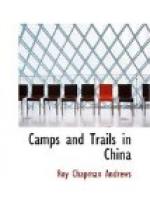The descent was gradual through a magnificent pine and spruce forest. Some of the trees were at least one hundred and fifty feet high, and were draped with beautiful gray moss which had looped itself from branch to branch and hung suspended in delicate streamers yards in length. The forest was choked with underbrush and a dense growth of dwarf bamboo, and the hundreds of fallen logs, carpeted with bronze moss, made ideal conditions for small mammal collecting. However, as all the species would probably be similar to those we had obtained on the Snow Mountain, we did not feel that it was worth while stopping to trap.
At four-thirty in the afternoon we camped upon a beautiful hill in a pine forest which was absolutely devoid of underbrush, and where the floor was thinly overlaid with brown pine needles. Although the Moso hunter, who acted as our guide, assured us that the river was only three miles away, it proved to be more than fifteen, and we did not reach the ferry until half past one the next afternoon.
We were continually annoyed, as every traveler in China is, by the inaccuracy of the natives, and especially of the Chinese. Their ideas of distance are most extraordinary. One may ask a Chinaman how far it is to a certain village and he will blandly reply, “Fifteen li to go, but thirty li when you come back.” After a short experience one learns how to interpret such an answer, for it means that when going the road is down hill and that the return uphill will require double the time.
Caravans are supposed to travel ten li an hour, although they seldom do more than eight, and all calculations of distance are based upon time so far as the mafus are concerned. If the day’s march is eight hours you invariably will be informed that the distance is eighty li, although in reality it may not be half as great.
In “Chinese Characteristics,” Dr. Arthur H. Smith gives many illuminating observations on the inaccuracy of the Chinese. In regard to distance he says:
It is always necessary in land travel to ascertain, when the distance is given in “miles” (li), whether the “miles” are “large” or not! That there is some basis for estimates of distances we do not deny, but what we do deny is that these estimates or measurements are either accurate or uniform.
It is, so far as we know, a universal experience that the moment one leaves a great imperial highway the “miles” become “long.” If 120 li constitute a fair day’s journey on the main road, then on country roads it will take fully as long to go 100 li, and in the mountains the whole day will be spent in getting over 80 li (p. 51).
In like manner, a farmer who is asked the weight of one of his oxen gives a figure which seems much too low, until he explains that he has omitted to estimate the bones! A servant who




